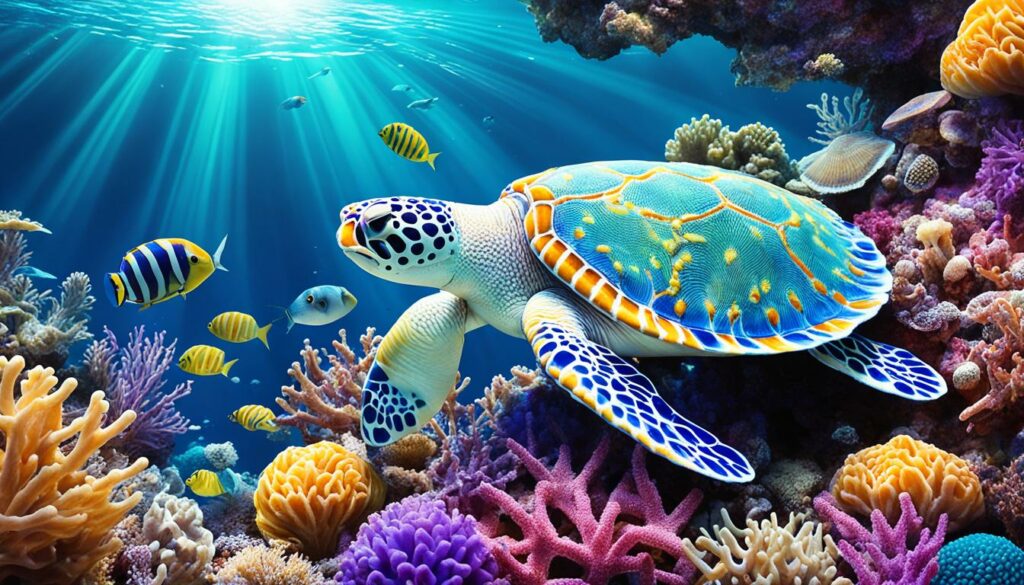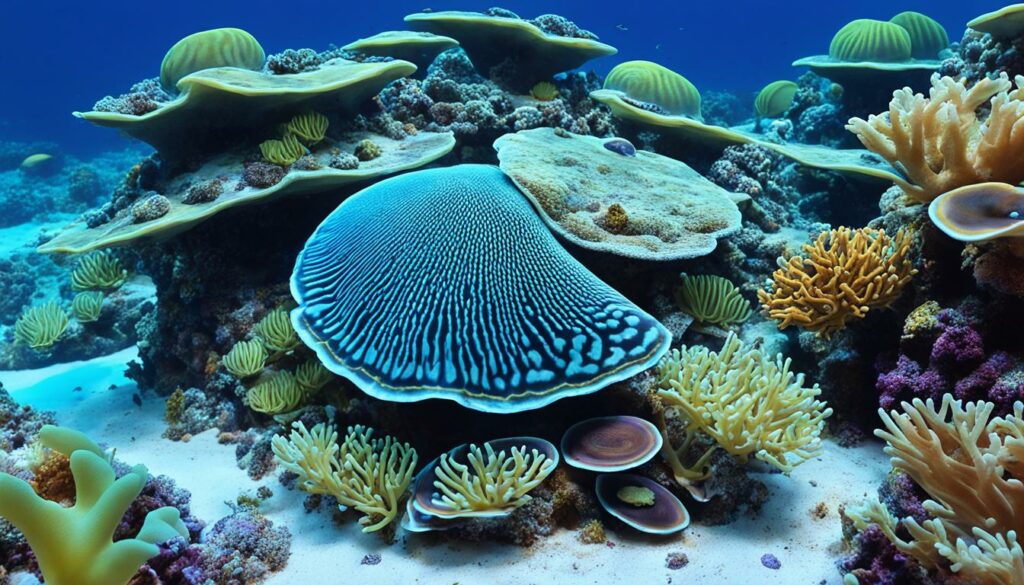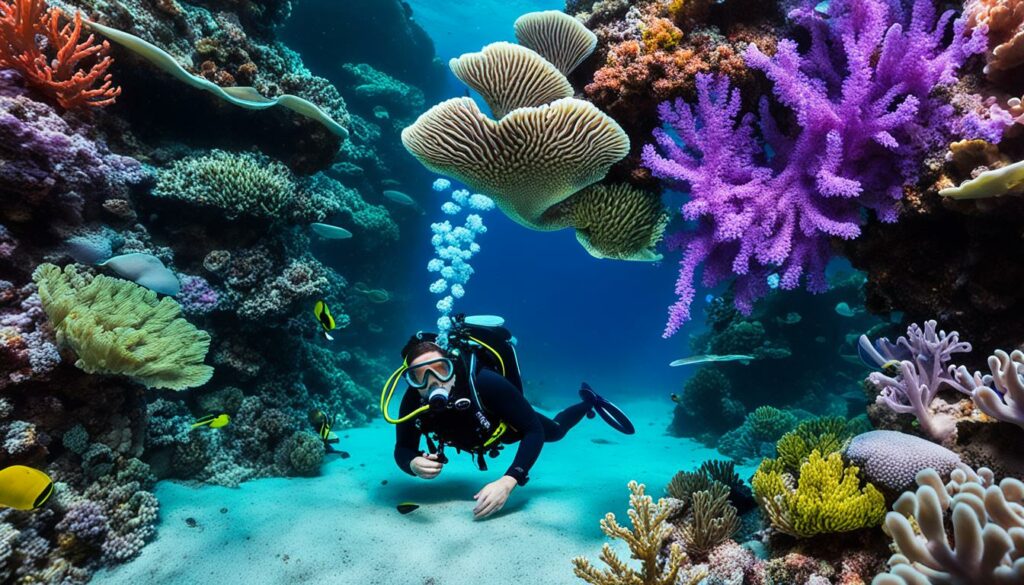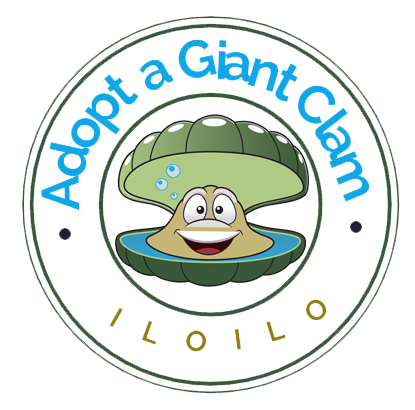Did you know the Tridacna Gigas, or giant clam, is the biggest mollusk alive? These huge creatures can reach up to 4 feet long and weigh over 500 pounds. They live in the warm waters of the Indo-Pacific, including the Philippines. The Tridacna Gigas is a fascinating and important species with a long history.

Key Takeaways
- Tridacna Gigas is the largest living mollusk, reaching up to 4 feet in length and 500 pounds in weight.
- These giant clams are found in the warm waters of the Indo-Pacific region, including the Philippines.
- Tridacna Gigas plays a crucial role in the marine ecosystem, providing food and habitat for other species.
- Conservation efforts are essential to protect this unique and important species.
- Tridacna Gigas can be found in some aquariums, but their care and maintenance require specialized knowledge.
Unveiling the Majestic Tridacna Gigas
The Tridacna Gigas, or giant clam, is a creature that stirs the imagination. It’s known for its huge size and long life, making it a standout in the ocean.
Its shell can grow over 4 feet long and weigh up to 500 pounds. This makes the Tridacna Gigas the biggest clam alive. The clam’s big, even valves show how much it can grow. Plus, it’s famous for living over a hundred years, which is very rare for an invertebrate.
The Tridacna Gigas is amazing because of its size and long life. This has made it a favorite among marine biologists and nature lovers. Exploring the giant clam reveals a lot about its unique ways and its role in the ocean.
| Characteristic | Tridacna Gigas |
|---|---|
| Maximum Shell Length | Over 4 feet (1.2 meters) |
| Maximum Weight | Up to 500 pounds (227 kg) |
| Maximum Lifespan | Over 100 years |
“The giant clam is a true marvel of the ocean, a living testament to the incredible diversity and resilience of marine life.”
Exploring the Habitat of Tridacna Gigas
The Tridacna Gigas, or giant clam, lives in the warm, shallow waters of the Indo-Pacific region. They love the vibrant coral reef ecosystems found in the ocean.
Where Do Giant Clams Thrive?
Tridacna Gigas do best in clear, rich waters. They stick to the seafloor or hard surfaces. This helps them get the protection, food, and perfect conditions to grow and have babies.
The Importance of Coral Reefs
Coral reefs are key to the ecosystem of Tridacna Gigas. They give the giant clams a safe place and lots of food. This shows how important it is for these clams and the marine environment to stay healthy.
“The fate of the giant clam is inextricably linked to the health of the coral reefs they call home. Protecting these vibrant ecosystems is essential for the continued survival of this magnificent species.”
The Remarkable Anatomy of Tridacna Gigas
Tridacna Gigas, the giant clam of the ocean, has a fascinating anatomy. It helps it live well in the sea. Its shell is made of two big, matching valves held together by a strong muscle.
The adductor muscle is key to the clam’s life. It lets the clam open and close its shell easily. This keeps the clam safe from predators and dangers.
The mantle lines the inside of the shell. It’s a soft layer that makes the clam colorful and patterned. The mantle is important for breathing and getting rid of waste.
The clam also has a siphon for bringing in water. It filters out nutrients and plankton, which are its main food. This special feature helps the giant clam live in coral reefs.
“The Tridacna Gigas is a true marvel of nature, with an anatomy that showcases the incredible diversity and adaptability of marine life.”
Tridacna Gigas: Ecological Significance
The Tridacna Gigas, or giant clam, is crucial to the health of marine ecosystems, especially coral reefs. Its size and beauty are just the start of its importance.
Symbiotic Relationships with Algae
The Tridacna Gigas is known for its special relationship with algae, called zooxanthellae. These tiny algae live inside the clam and make food through photosynthesis. The clam gives them a safe place and the waste they need to grow. This relationship shows how life in coral reefs is connected.
Roles in Marine Ecosystems
The Tridacna Gigas is more than just a home for algae. It’s a key food source and shelter for many sea creatures. Its big shell is a safe spot for fish, crustaceans, and other invertebrates. This helps keep the ocean diverse and balanced.
Also, the clam helps keep the water clean by filtering it. This is key to the ocean’s health.

“The Tridacna Gigas is a true marvel of nature, serving as a keystone species in the fragile coral reef ecosystems it calls home.”
| Ecological Role | Importance |
|---|---|
| Symbiotic Relationship with Algae | Provides the clam with essential nutrients and energy, while the algae benefit from the clam’s waste products. |
| Food Source and Habitat | Serves as a food source and provides shelter and breeding grounds for diverse marine species, contributing to ecosystem biodiversity. |
| Water Filtration | Helps maintain the clarity and health of surrounding waters through its filter-feeding abilities. |
Threats to the Tridacna Gigas Population
The Tridacna Gigas, or giant clam, is a vital part of coral reef ecosystems. It faces many threats, leading to a worrying decline in its numbers over the years.
Overfishing is a big threat to the Tridacna Gigas. People want their meat and beautiful shells, which has led to a huge drop in some populations. Some have seen a decline of up to 90%.
Another threat is habitat destruction, especially the damage to coral reefs. These activities include coastal development, pollution, and harmful fishing. The giant clams live in these fragile environments, which are being destroyed.
Climate change also harms the Tridacna Gigas. Rising ocean temperatures and acid levels make it hard for the clams to survive. This disrupts the balance of the coral reef ecosystem.
| Threat | Impact on Tridacna Gigas |
|---|---|
| Overfishing | Dramatic population decline (up to 90%) |
| Habitat Destruction | Degradation of coral reef ecosystems |
| Climate Change | Disruption of the coral reef ecosystem |
The threats to the Tridacna Gigas are complex. We need to act fast to protect this amazing species and its home.
“The Tridacna Gigas is a true marvel of the marine world, and we must do everything in our power to ensure its survival for future generations.”
Conservation Efforts for Tridacna Gigas
The giant clam, also known as Tridacna Gigas, is in trouble. Its numbers are going down. We need to act fast to save these important sea creatures. They play a big role in keeping coral reefs healthy.
Sustainable Practices
It’s important to fish responsibly to protect the giant clams. We should set limits on how many we catch and support sustainable farming and restocking. This way, we can make sure there are enough giant clams for the future.
Protecting Coral Reefs
Giant clams live in coral reefs, so saving these reefs is key. We need to fight against ocean acidification, pollution, and bad fishing. Keeping coral reefs healthy helps giant clams and many other sea creatures thrive.
| Conservation Measures | Impact on Tridacna Gigas |
|---|---|
| Sustainable fishing practices | Ensures the long-term survival of Tridacna Gigas populations by regulating catch sizes and enforcing regulations |
| Coral reef protection | Safeguards the primary habitat of Tridacna Gigas, allowing for the continued growth and reproduction of these giant clams |
| Aquaculture and restocking initiatives | Replenishes Tridacna Gigas populations through the cultivation and release of these clams into their natural environments |
We can save the giant clams by using a mix of strategies. This includes sustainable fishing, protecting coral reefs, and farming and releasing more clams. Together, we can keep these amazing creatures around for a long time.

Tridacna Gigas in Captivity
Tridacna Gigas, the giant clam, is mostly found in the wild. Yet, there’s a growing effort to keep them in captivity, in aquariums and aquaculture. To care for these clams, you need to pay close attention to their needs. This includes the right lighting, water flow, and nutrients for their health.
Aquarium Care and Maintenance
Aquarium lovers and conservation groups have worked hard to learn how to care for Tridacna Gigas in captivity. Their research has given us valuable tips. Now, aquarium owners can create the best home for these giant clams. They need the right water conditions, lighting, and water movement.
- Provide ample lighting to mimic the natural conditions of their tropical habitats
- Maintain water flow and circulation to replicate the natural currents they experience
- Monitor and regulate water chemistry, including pH, temperature, and nutrient levels
- Introduce a diverse range of microalgae and phytoplankton to support their symbiotic relationship with zooxanthellae
Following these best practices helps aquarium fans and conservation groups care for Tridacna Gigas. They’re making a big difference in protecting this amazing species.
“The captive care of Tridacna Gigas is a testament to the dedication and innovation of aquarium enthusiasts and conservation organizations, who are working tirelessly to protect and preserve this iconic species.”
Fascinating Facts about Tridacna Gigas
The Tridacna Gigas, or giant clam, is an amazing ocean creature. It can live over a hundred years, making it one of the longest-living invertebrates. Its colors and patterns come from algae living inside it, showing the ocean’s beauty.
Tridacna Gigas is key to keeping marine ecosystems healthy. It acts as a natural filter, keeping coral reefs balanced. This shows how important our oceans are for life on Earth.
This species is known for its long life, beautiful look, and role in nature. Learning about it helps us appreciate the ocean more. It also shows why we must protect it for the future.
FAQ
What is the Tridacna Gigas?
The Tridacna Gigas, also known as the giant clam, is a big mollusk. It lives in the warm waters of the Indo-Pacific region, including the Philippines. It’s the biggest mollusk alive, with some growing over 4 feet long and weighing over 500 pounds.
Where do giant clams thrive?
Tridacna Gigas lives in the warm, shallow waters of the Indo-Pacific region. It loves areas with healthy coral reefs. These giant clams do well in clear, rich waters, sticking to the seafloor or hard surfaces.
What is the unique anatomy of Tridacna Gigas?
Tridacna Gigas has a special anatomy for its marine life. Its shell has two big, symmetrical parts held together by a strong muscle. The clam uses this to open and close its shell.
The clam’s mantle, a fleshy layer inside the shell, shows off its colors and patterns. It also has a siphon to draw in water and filter out food.
What is the ecological significance of Tridacna Gigas?
Tridacna Gigas is key to the health of marine ecosystems, especially coral reefs. It has a special relationship with algae that live inside it. This helps the clam and the ecosystem.
As a food source and home for many marine animals, the giant clam helps keep the ocean diverse and balanced.
What threats are facing Tridacna Gigas populations?
Tridacna Gigas populations are dropping due to many threats. Overfishing for food and the aquarium trade, destroying their homes, and climate change are big problems. Ocean acidification and warming hurt the giant clam too.
What conservation efforts are in place for Tridacna Gigas?
To help Tridacna Gigas, conservation efforts are underway. Sustainable fishing and protecting coral reefs are key. Also, breeding giant clams in captivity and restoring their habitats are important.
How are Tridacna Gigas cared for in captivity?
Some Tridacna Gigas are kept in aquariums and farms. They need the right conditions, like good lighting and water flow, to stay healthy. People who love aquariums and conservation groups are helping learn how to care for them.
What are some fascinating facts about Tridacna Gigas?
Tridacna Gigas is an amazing creature with many interesting facts. For example, it can live over 100 years, making it one of the longest-living invertebrates. Its colors and patterns come from algae living inside it.
This clam is vital for the health of the ocean, making it a fascinating study subject.

